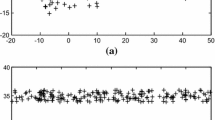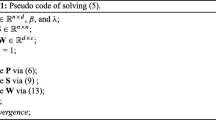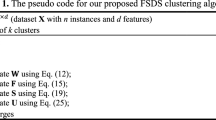Abstract
Clustering is often considered as an unsupervised data analysis method, but making full use of the prior information in the process of clustering will significantly improve the performance of the clustering algorithm. Spectral clustering algorithm can well use the prior pairwise constraint information to cluster and has become a new hot spot of machine learning research in recent years. In this paper, we propose an effective clustering algorithm, called a semi-supervised spectral clustering algorithm based on pairwise constraints, in which the similarity matrix of data points is adjusted and optimized by pairwise constraints. The experiments on real-world data sets demonstrate the effectiveness of this algorithm.






Similar content being viewed by others
References
Jain A, Murty M, Flynn P (1999) Data clustering: a review. ACM Comput Surv 31(3):264–323
Ding SF, Zhang LW, Zhang Y (2010) Research on spectral clustering algorithms and prospects. In: The 2nd international conference on computer engineering and technology (ICCET 2010), vol 6, April 16–18, 2010. Chengdu, pp 149–153
Fiedler M (1973) Algebraic connectivity of graphs. Czech Math J 23:298–305
Gao Y, Gu SW, Tang J (2007) Research on spectral clustering in machine learning. Comput Sci 34(2):201–203
Malik J, Belongie S, Leung T, et al (2000) Contour and texture analysis for image segmentation. In: Perceptual organization for artificial vision systems, Kluwer, Dordrecht
Weiss Y (1999) Segmentation using eigenvectors: a unified view. In: International conference on computer vision
Shi J, Malik J (2000) Normalized cut s and image segmentation. IEEE Trans Pattern Anal Mach Intell 22(8):888–905
Celikyilmaz A (2009) Soft-link spectral clustering for information extraction. In: IEEE third international conference on semantic computing (ICSC 2009), pp 434–441
de Sa VR, Gallagher PW, Lewis JM, Malave VL (2010) Multi-view kernel construction. Mach Learn 79(1–2):47–71
Zhang XC, You QZ (2011) An improved spectral clustering algorithm based on random walk. Front Comput Sci China 5(3):268–278
Liu XY, Yong X, Lin HF (2011) An improved spectral clustering algorithm based on local neighbors in kernel space. Comput Sci Inf Syst 8(4):1143–1157
Wang Y, Jiang Y, Wu Y, Zhou ZH (2011) Spectral clustering on multiple manifolds. IEEE Trans Neural Netw 22(7):1149–1161
Nie FP, Zeng ZN, Tsang IW, Xu D, Zhang CS (2011) Spectral embedded clustering: a framework for in-sample and out-of-sample spectral clustering. IEEE Trans Neural Netw 22(11):1796–1808
Zhao F, Liu HQ, Jiao LC (2011) Spectral clustering with fuzzy similarity measure. Digit Signal Process 21(6):701–709
Chen WY, Song YQ, Bai HJ et al (2011) Parallel spectral clustering in distributed systems. IEEE Trans Pattern Anal Mach Intell 33(3):568–586
**ao Y, Yu J (2008) Semi-supervised clustering based on affinity propagation algorithm. J Softw 19(11):2803–2813
Wang L, Bo LF, Jiao LC (2007) Density-sensitive semi-supervised spectral clustering. J Softw 18(10):2412–2422
Wang N, Li X (2010) Active semi-supervised spectral clustering based on pairwise constraints. Acta Electronica Sinica 38(1):172–176
Cai XY, Dai GZ, Yang LB (2008) Survey on spectral clustering algorithms. Comput Sci 35(7):14–18
Ng AY, Jordan MI, Weiss Y (2002) On spectral clustering: analysis and an algorithm. Adv Neural Inf Process Syst 14: 849–856
Li CL, Cao Z, Cao LP et al (2009) Some developments on semi-supervised clustering. Recognit Artif Intell 22(5):735–742
Zhong Shi (2006) Semi-supervised model-based document clustering: a comparative study. Mach Learn 65(1):3–29
Wagstaff K, Cardie C (2000) Clustering with instance-level constraints. In: Proceedings of the 17th international conference on machine learning, San Francisco, pp 1103–1110
Si WW, Qian YT (2005) Semi-supervised clustering based on spectral clustering. Comput Appl 25(6):1347–1349
Yin XS, Hu EL, Chen SC (2008) Discriminative semi-supervised clustering analysis with pairwise constraints. J Softw 19(11):2791–2802
Davidon I, Ravi S (2007) The complexity of non-hierarchical clustering with instance and cluster level constraints. Data Min Knowl Disc 14(1):25–61
Xu QJ, Desjardins M, Wagstaff K (2005) Constrained spectral clustering under a local proximity structure assumption. In: Proceedings of the 18th international conference of the Florida artificial intelligence research society (FLAIRS-05), Clearwater Beach, FL
Klein D, Kamvar SD, Manning C (2002) From instance-level constraints to space-level constraints: making the most of prior knowledge in data clustering. In: Proceedings of the 19th international conference on machine learning. Sydney, pp 307–314
Jiang XQ (2008) Semi supervised clustering algorithm and its application and research. Jiangnan University, Wuxi
Lei XF, **e KQ, Lin F et al (2008) An efficient clustering algorithm based on local optimality of k-means. J Softw 19(7):1683–1692
Acknowledgments
This work is supported by the National Basic Research Program of China (No. 2013CB329502), the National Natural Science Foundation of China (No. 41074003) and the Opening Foundation of Key Laboratory of Intelligent Information Processing of Chinese Academy of Sciences (No. IIP2010-1).
Author information
Authors and Affiliations
Corresponding author
Rights and permissions
About this article
Cite this article
Ding, S., Jia, H., Zhang, L. et al. Research of semi-supervised spectral clustering algorithm based on pairwise constraints. Neural Comput & Applic 24, 211–219 (2014). https://doi.org/10.1007/s00521-012-1207-8
Received:
Accepted:
Published:
Issue Date:
DOI: https://doi.org/10.1007/s00521-012-1207-8




